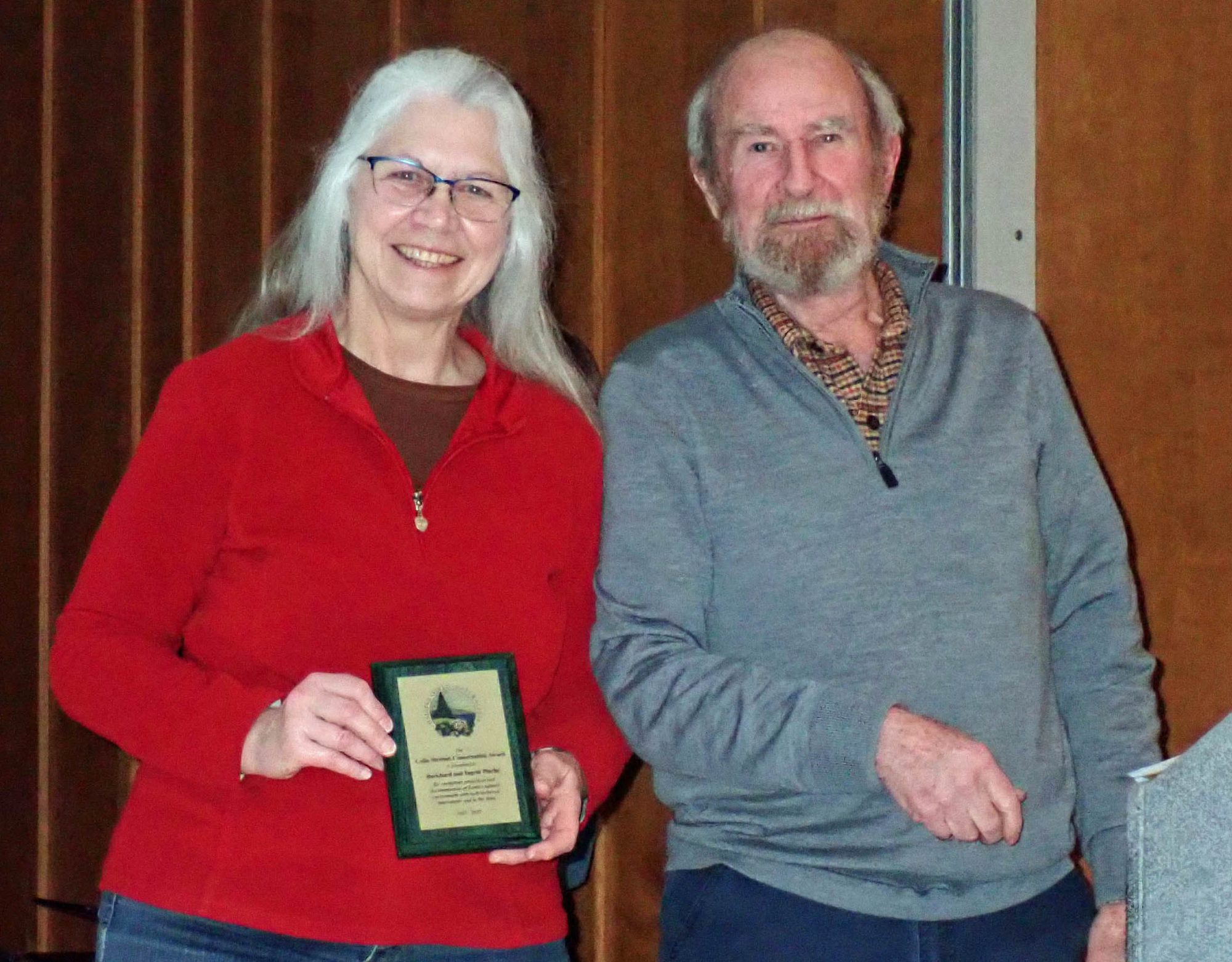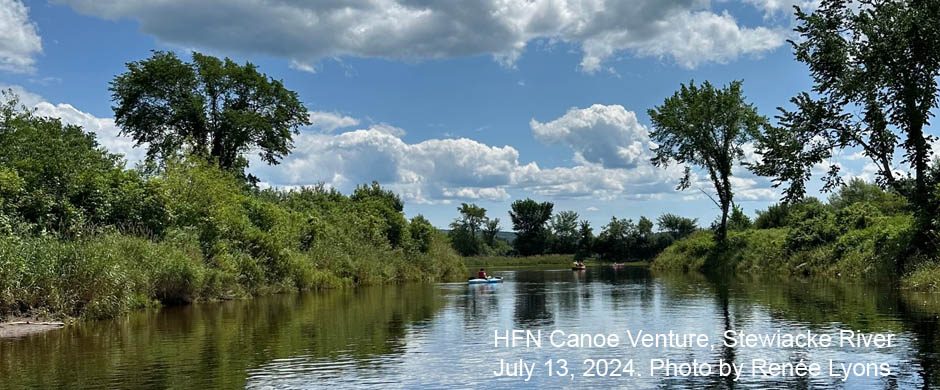The 2024 Colin Steward Award: Burkhard & Ingrid Plache

Ingrid receives award from Allan Robertson at HFN meeting on 15 April 2025.
Burkhard and Ingrid Plache have been active members of HFH since their arrival in Halifax many years ago. Burkhard served as our President from 2017 to 2022 when, in the latter year, he passed away in a tragic event. Ingrid continues to an active member and board member (Treasurer) of HFN.
One of the criteria that a nominee or nominees for the Colin Stewart Award must fulfil is that the work they undertake toward promoting and preserving nature will last into the future for others to use, benefit from, and carry on. Both botanist Ingrid and Burkhard Plache more than adequately fulfil that criterion.
Halifax Field Naturalists
For seven and a half more than capable years both botanist Ingrid Plache and physicist Burkhard Plache served on HFN’s Programme Committee from September 2003 to February 2011, leading and organising field trips, recording meticulous species lists for us, and teaching field trip participants how to recognise and identify plant species. Both served on HFN’s Board of directors for twelve years from March, 2005 to February 2017, with Ingrid still continuing to this day as Treasurer (20 years and counting) and Burkhard serving as President from March 2017 to September 2022. And, from December 2019 to August 2022 Burkhard took over organising and successfully solving difficulties with our AV set-up while serving on the Programme Committee once more.
Nature Conservancy of Canada, Nova Scotia Nature Trust, and Nature Nova Scotia
Besides their significant volunteerism on the Board of the Halifax Field Naturalists, Ingrid and Burkhard were steadfast partners in all the fieldwork they did with each other, both for HFN and for the other above groups. Burkhard also served on the Nature Nova Scotia Board of Directors.
Formally recognised as Leaders in Conservation by the Nature Conservancy of Canada, for many years Ingrid and Burkhard conducted field surveys for Nova Scotia Nature Trust (NSNT). They began volunteering with the Nature Trust in 2018, and this took them to many places – Cape LaHave Island, Baddeck River, Wentworth Valley, Seal Island, Sandy Lake Conservation lands, and the Cameron Lake lands in South West Nova Scotia as Property Guardians. In July of 2018 their participation in Wentworth was for a bioblitz in the area. For Cape LaHave Island in August 2020, along with a team of biologists from the Atlantic Canada Conservation Data Centre (ACCDC) and the NS Museum of Natural History, they represented the Nature Trust in conducting a four-day biodiversity inventory.
Their work supported the important development of flora/fauna baseline and stewardship documents for that island. In the summer of 2019, along with NSNT’s Joanna Skomorowski, they spent four days on Seal Island, followed by a week in the Mabou area. They also conducted field surveys at Plaister Cliffs in 2020 (for a whole week in temperatures of 30?C, scrambling over and through an extremely difficult terrain of intense karst topography) and the Lime Hill area in 2021. They helped with other baseline surveys on new properties, documenting forest cover, shrub cover, herbaceous plants, and broad categories of mosses. They would bring back sprigs of plants and sometimes spend the evening poring over the Flora of Nova Scotia to identify them; Burkhard always liked to sit down at the end of the day and go over where they’d been and what they’d seen. They learned to use the tablets when NSNT finally obtained them, and also NSNT’s database programme “Landscape”.
Burkhard was always keenly interested to share new or interesting plant sightings, and had a wonderful sense of humour. Ingrid and he used to go into the bogs and wetlands barefoot, as they found it easier on their feet. Their essential help enabled NSNT to cover more ground than usual on both their larger and smaller properties. They were so trustworthy and experienced that they only had to be set up with property boundaries and the day’s plan, and off they would go. Lastly, Ingrid and Burkhard were featured by the Nova Scotia Trust as Volunteers of the Month in 2020. Summing up, they have been hardworking stalwarts for the natural environment and its conservation in Nova Scotia for many years, being well known participants in a large number of nature related surveys, organisations, and initiatives.
Halifax Regional Municipality
Both Ingrid and Burkhard were actively involved both with the Williams Lake Conservation Company and with Shaw Natural Wilderness Park. Burkhard donated money to Shaw Park near Jollimore and was very active as a volunteer in its upkeep and refurbishment by removing trees after a storm and helping to improve its trails. They contributed so much that their names appear on this park’s entrance sign. For a long time they were also both intimately engaged with the inauguration, preservation, and stewardship of the Purcell’s Cove Conservation ‘Backlands’.
Burkhard’s Career – IOSAT, Satlantic, NASA, MDA
Burkhard is unique to our 21-year roster of Colin Stewart Conservation Award recipients in that not only did he significantly volunteer, and contribute to nature conservation in the field, for nature-oriented organisations, for twenty six years he had a remarkable career developing and designing cutting-edge sensing technologies in order to advance scientific understanding of our world’s fragile oceanic ecosystems upon which all life on earth ultimately depends.
In 1996 he joined IOSAT, a Halifax start-up formed to build transportable satellite reception stations for the emergent commercial earth-observation market. He developed state-of-the-art software for producing imagery from the radar sensor on Canada’s ground-breaking RADARSAT earth-observation satellite. Using his background in physics, mathematics, and computing, he devised a programme to decode this satellite’s microwave echo return data in order to produce precise geopositioning sea-surface imagery; moreover, it was optimised for real-time performance. He then focused on developing software to detect and quantify maritime features such as wind speed/direction, wave height, oil slicks, ice cover, and ships. Importantly, this technology has since been used to successfully stop industrial-scale illegal fishing and bilge-dumping in those remote marine areas formerly inaccessible to monitoring.
After IOSAT wrapped up, Burkhard stayed on with its parent company Satlantic. Satlantic specialised in the commercialisation of in-situ sensors measuring the optical properties of water. Here he went on to develop many very important processes. One of them was the devising of algorithms for determining photosynthetic properties of phytoplankton at extremely low concentrations. (Phytoplankton are the global foundation for all marine life and ecosystems, the oceanic food web, and earth’s climate system. They produce oxygen thereby helping to regulate carbon dioxide levels. They play an essential role in recycling and remineralising materials and energy within the food chain. Larger and larger zooplankton, fish, birds, and marine mammals depend on these plankton for their survival. Also, they are frequently indicators of ecosystem change). He developed compact, digital nitrate analysers using ultraviolet absorption spectroscopy to accurately measure harmful nitrate build-up in a range of ocean conditions – from turbid, nitrate-rich coastal zones to cold, dark ocean depths with only traces of nitrate (the right amount of oceanic nitrates are essential to healthy levels of phytoplankton). He implemented calibration processes to accurately measure and monitor ocean acidification due to global warming. He engineered optical sensors for the measurement of the oceans’ photosynthetically active radiation in order to show the avail ability of light needed for photosynthesis.
For NASA, he investigated ocean radiance transfer, increasing its accuracy by including corrections for stray light and temperature variation. He engineered a solar-tracking platform for ships so that they could measure surface reflectance and water-leaving irradiance to maintain optimal radiometer orientation with respect to the sun. Burkhard also developed a dual hyperspectral radiometer system for a fleet of robotic floats drifting on ocean currents, repeatedly diving and sampling the water column up to two kilometres deep. Upon resurfacing they send the collected results to be collated and measured via satellite uplink.
Then, working at MDA, he led a team of engineers working on a Maritime Situation Awareness system for NATO. He led another team which developed a communication and control subsystem for a crewless space shuttle that will resupply the International Space Station. In a way, Burkhard’s last assignment was a return to the beginning. He once again developed algorithms for processing radar imagery for a new radar satellite constellation which will more accurately image the earth and its oceans from space.
His professional work, along with his and Ingrid’s field work, has truly helped, and will continue to help, the earth to be a better place.
Read more about the Colin Stewart Conservation Award
